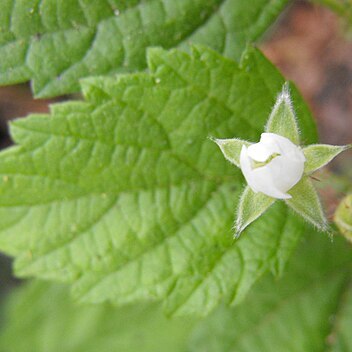Shrubs, 10–30 dm, armed. Stems ?biennial?, ascending, often arching, glabrous or sparsely puberulent, eglandular or sparsely to densely short-stipitate-glandular, strongly pruinose; prickles moderate to dense, erect or curved, slender to stout, 4–8 mm, usually broad-based, sometimes narrow-based. Leaves deciduous, palmately compound or ternate; stipules filiform, 5–10 mm; ?petiole with hooked or erect prickles, glabrous, eglandular or sparsely to densely sessile-to short-stipitate-glandular; lateral leaflets stalked, at least 2 larger ones, often with prickles, glabrous, eglandular or stipitate-glandular?; leaflets 3–5(–7), terminal ovate to lanceolate, 6–10 × 3–6 cm, base cordate to truncate, unlobed or shallowly 3-lobed, margins serrate to doubly serrate, apex acuminate, abaxial surface sometimes with prickles on midrib and some lateral veins, glabrous to strongly white-tomentose, usually eglandular. Inflorescences axillary and terminal, (1–)3–10(–12)-flowered, flat-topped cymiform or umbelliform. Pedicels: prickles sparse to dense, hooked or erect, puberulent, eglandular or sparsely to densely sessile-or short-stipitate-glandular. Flowers bisexual; petals ?erect, then ascending?, white, oblong to oblanceolate, 3–6(–8) mm; filaments laminar; ovaries pubescent, rarely glabrous. Fruits reddish purple to nearly black, depressed globose to conic, 1–2 cm; drupelets 20–60, coherent, separating from torus. 2n = 14.
More
A shrub. It loses its leaves during the year. The canes arch over and have prickles. The bark is smooth and red with a waxy covering. The leaves have prickles on the veins. The leaves are compound and white underneath. There are 2 side leaflets and a larger one at the end. The flowers are white and often in clusters. The fruit is a purple to black berry.
Moist to dry, open, often rocky areas, shaded roadsides, sheltered openings, thickets, open forests; at elevations up to 2,700 metres.
More
It is a temperate plant. It grows in open clearings in woods.
Can be grown by cuttings or seedlings. Seeds needs stratification.

